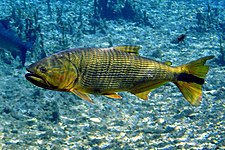Salminus brasiliensis: Difference between revisions
No edit summary |
|||
| Line 25: | Line 25: | ||
This section is quite pathetic |
This section is quite pathetic |
||
The life cycle can be anything from 5 to 15 years. |
|||
==Life Cycle== |
|||
Needs info |
|||
==Diet== |
==Diet== |
||
Revision as of 21:40, 28 August 2011
| Dorado | |
|---|---|

| |
| Scientific classification | |
| Kingdom: | |
| Phylum: | |
| Class: | |
| Order: | |
| Family: | |
| Genus: | |
| Species: | S. brasiliensis
|
| Binomial name | |
| Salminus brasiliensis (Cuvier, 1816)
| |
The Golden Dorado (Salminus maxillosus or Salminus brasiliensis) is a large river fish that lives in South America. Despite having Salminus in its name, the dorado is not related to any species of salmon, nor to the saltwater fish also called dorado.
Description
Dorado have large heads, with powerful jaws that are filled with sharp teeth. They reach maturity around 37 centimetres (15 in) long, and are golden colored. The average size of the golden dorado is about 3-10 kilograms. The largest recorded size is 100 cm length and 31.4 kg (69 pounds)[1].
Distribution and habitat
Dorado live in the warm waters of the La Plata Basinand the Amazon systems in South America, specifically in Brazil (where it's called Dourado - from Ouro, the Portuguese for Gold) Argentina, Paraguay, Uruguay, and Bolivia, and also in the São Francisco River system in Brazil. The dorado is considered an endangered species in Paraguay and therefore a 5-year fishing ban is currently on effect there.[2] This section is quite pathetic
The life cycle can be anything from 5 to 15 years.
Diet
Dorados are piscivores, eating a wide variety of prey fish. One of the dorado's favorite prey are sabalo, a type of schooling fish typically 1-4 kg in weight.
The Dorado is highly sought-after by anglers, both for its delicious taste and fighting ability. It is, however, extremely difficult to catch. The aggressive nature of the dorado, its high jumps, and great fighting strength and stamina have created a great competitive market among anglers from all corners of the world, traversing South American waters in hopes of hooking a dorado.
Culinary Preparation
Dorados are excellent to eat and are often barbecued with tomatoes and bell peppers. Often utilized in the making of fish soups they are also popularly fried in South America. The Dorado has a white flaky flesh with a notably high fat content.
Behavior
Dorado mainly travel in small groups.
Dorado in Popular Culture
The dorado is featured in the GCN game Animal Crossing as well as its two sequels, the NDS game Animal Crossing: Wild World and the Wii game Animal Crossing: City Folk as an extremely rare fish.
References
- ^ http://www.fishbase.org/Summary/speciesSummary.php?ID=56329&genusname=Salminus&speciesname=brasiliensis
- ^ Law Number 3191/07, Which prohibits the fishing, extraction, collecting and stocking for ulterior commercialization of the species Salminus maxillosus, of common name Dorado fish. (MS Word Document) (In Spanish). Retrieved on 20 November 2010.
